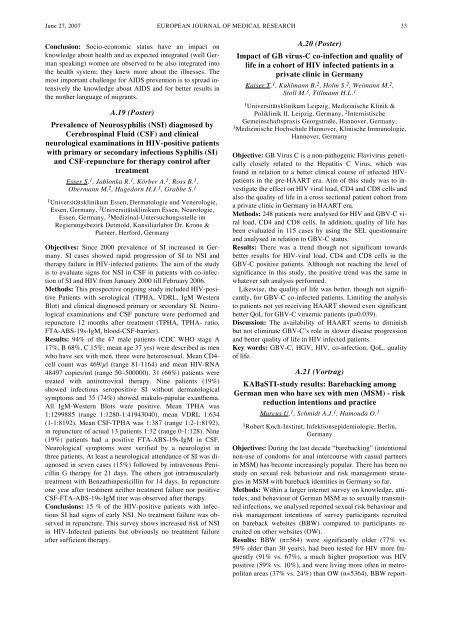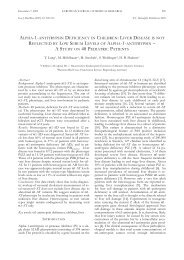European Journal of Medical Research - Deutsche AIDS ...
European Journal of Medical Research - Deutsche AIDS ...
European Journal of Medical Research - Deutsche AIDS ...
You also want an ePaper? Increase the reach of your titles
YUMPU automatically turns print PDFs into web optimized ePapers that Google loves.
June 27, 2007 EUROPEAN JOURNAL OF MEDICAL RESEARCH<br />
33<br />
Conclusion: Socio-economic status have an impact on<br />
knowledge about health and as expected integrated (well German<br />
speaking) women are observed to be also integrated into<br />
the health system; they knew more about the illnesses. The<br />
most important challenge for <strong>AIDS</strong> prevention is to spread intensively<br />
the knowledge about <strong>AIDS</strong> and for better results in<br />
the mother language <strong>of</strong> migrants.<br />
A.19 (Poster)<br />
Prevalence <strong>of</strong> Neurosyphilis (NSI) diagnosed by<br />
Cerebrospinal Fluid (CSF) and clinical<br />
neurological examinations in HIV-positive patients<br />
with primary or secondary infectious Syphilis (SI)<br />
and CSF-repuncture for therapy control after<br />
treatment<br />
Esser S. 1 , Jablonka R. 1 , Körber A. 1 , Ross B. 1 ,<br />
Obermann M. 2 , Hagedorn H.J. 3 , Grabbe S. 1<br />
1 Universitätsklinikum Essen, Dermatologie und Venerologie,<br />
Essen, Germany, 2 Universitätsklinikum Essen, Neurologie,<br />
Essen, Germany, 3 Medizinal-Untersuchungsstelle im<br />
Regierungsbezirk Detmold, Konsiliarlabor Dr. Krone &<br />
Partner, Herford, Germany<br />
Objectives: Since 2000 prevalence <strong>of</strong> SI increased in Germany.<br />
SI cases showed rapid progression <strong>of</strong> SI to NSI and<br />
therapy failure in HIV-infected patients. The aim <strong>of</strong> the study<br />
is to evaluate signs for NSI in CSF in patients with co-infection<br />
<strong>of</strong> SI and HIV from January 2000 till February 2006.<br />
Methods: This prospective ongoing study included HIV-positive<br />
Patients with serological (TPHA, VDRL, IgM Western<br />
Blot) and clinical diagnosed primary or secondary SI. Neurological<br />
examinations and CSF puncture were performed and<br />
repuncture 12 months after treatment (TPHA, TPHA- ratio,<br />
FTA-ABS-19s-IgM, blood-CSF-barrier).<br />
Results: 94% <strong>of</strong> the 47 male patients (CDC WHO stage A<br />
17%, B 68%, C 15%; mean age 37 yrs) were described as men<br />
who have sex with men, three were heterosexual. Mean CD4-<br />
cell count was 469/l (range 81-1164) and mean HIV-RNA<br />
48497 copies/ml (range 50–500000). 31 (66%) patients were<br />
treated with antiretroviral therapy. Nine patients (19%)<br />
showed infectious seropositive SI without dermatological<br />
symptoms and 35 (74%) showed makulo-papular exanthema.<br />
All IgM-Western Blots were positive. Mean TPHA was<br />
1:1299885 (range 1:1280-1:41943040), mean VDRL 1:634<br />
(1-1:8192). Mean CSF-TPHA was 1:387 (range 1:2-1:8192),<br />
in repuncture <strong>of</strong> actual 13 patients 1:32 (range 0-1:128). Nine<br />
(19%) patients had a positive FTA-ABS-19s-IgM in CSF.<br />
Neurological symptoms were verified by a neurologist in<br />
three patients. At least a neurological attendance <strong>of</strong> SI was diagnosed<br />
in seven cases (15%) followed by intravenous Penicillin<br />
G therapy for 21 days. The others got intramuscularly<br />
treatment with Benzathinpenicillin for 14 days. In repuncture<br />
one year after treatment neither treatment failure nor positive<br />
CSF-FTA-ABS-19s-IgM titer was observed after therapy.<br />
Conclusions: 15 % <strong>of</strong> the HIV-positive patients with infectious<br />
SI had signs <strong>of</strong> early NSI. No treatment failure was observed<br />
in repuncture. This survey shows increased risk <strong>of</strong> NSI<br />
in HIV-Infected patients but obviously no treatment failure<br />
after sufficient therapy.<br />
A.20 (Poster)<br />
Impact <strong>of</strong> GB virus-C co-infection and quality <strong>of</strong><br />
life in a cohort <strong>of</strong> HIV infected patients in a<br />
private clinic in Germany<br />
Kaiser T. 1 , Kuhlmann B. 2 , Holm S. 2 , Weimann M. 2 ,<br />
Stoll M. 3 , Tillmann H.L. 1<br />
1 Universitätsklinikum Leipzig, Medizinische Klinik &<br />
Poliklinik II, Leipzig, Germany, 2 Internistische<br />
Gemeinschaftspraxis Georgstraße, Hannover, Germany,<br />
3 Medizinische Hochschule Hannover, Klinische Immunologie,<br />
Hannover, Germany<br />
Objective: GB Virus C is a non-pathogenic Flavivirus genetically<br />
closely related to the Hepatitis C Virus, which was<br />
found in relation to a better clinical course <strong>of</strong> infected HIVpatients<br />
in the pre-HAART era. Aim <strong>of</strong> this study was to investigate<br />
the effect on HIV viral load, CD4 and CD8 cells and<br />
also the quality <strong>of</strong> life in a cross sectional patient cohort from<br />
a private clinic in Germany in HAART era.<br />
Methods: 248 patients were analysed for HIV and GBV-C viral<br />
load, CD4 and CD8 cells. In addition, quality <strong>of</strong> life has<br />
been evaluated in 115 cases by using the SEL questionnaire<br />
and analysed in relation to GBV-C status.<br />
Results: There was a trend though not significant towards<br />
better results for HIV-viral load, CD4 and CD8 cells in the<br />
GBV-C positive patients. Although not reaching the level <strong>of</strong><br />
significance in this study, the positive trend was the same in<br />
whatever sub analysis performed.<br />
Likewise, the quality <strong>of</strong> life was better, though not significantly,<br />
for GBV-C co-infected patients. Limiting the analysis<br />
to patients not yet receiving HAART showed even significant<br />
better QoL for GBV-C viraemic patients (p=0.039).<br />
Discussion: The availability <strong>of</strong> HAART seems to diminish<br />
but not eliminate GBV-C’s role in slower disease progression<br />
and better quality <strong>of</strong> life in HIV infected patients.<br />
Key words: GBV-C, HGV, HIV, co-infection, QoL, quality<br />
<strong>of</strong> life.<br />
A.21 (Vortrag)<br />
KABaSTI-study results: Barebacking among<br />
German men who have sex with men (MSM) - risk<br />
reduction intentions and practice<br />
Marcus U. 1 , Schmidt A.J. 1 , Hamouda O. 1<br />
1 Robert Koch-Institut, Infektionsepidemiologie, Berlin,<br />
Germany<br />
Objectives: During the last decade “barebacking” (intentional<br />
non-use <strong>of</strong> condoms for anal intercourse with casual partners<br />
in MSM) has become increasingly popular. There has been no<br />
study on sexual risk behaviour and risk management strategies<br />
in MSM with bareback identities in Germany so far.<br />
Methods: Within a larger internet survey on knowledge, attitudes,<br />
and behaviour <strong>of</strong> German MSM as to sexually transmitted<br />
infections, we analysed reported sexual risk behaviour and<br />
risk management intentions <strong>of</strong> survey participants recruited<br />
on bareback websites (BBW) compared to participants recruited<br />
on other websites (OW).<br />
Results: BBW (n=564) were significantly older (77% vs.<br />
59% older than 30 years), had been tested for HIV more frequently<br />
(91% vs. 67%), a much higher proportion was HIV<br />
positive (59% vs. 10%), and were living more <strong>of</strong>ten in metropolitan<br />
areas (37% vs. 24%) than OW (n=5364). BBW report-





